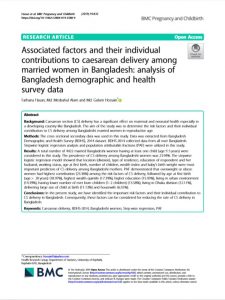
Background
Caesarean section (CS) delivery has a significant effect on maternal and neonatal health especially in a developing country like Bangladesh. The aim of the study was to determine the risk factors and their individual contribution to CS delivery among Bangladeshi married women in reproductive age.
Methods
The cross sectional secondary data was used in this study. Data was extracted from Bangladesh Demographic and Health Survey (BDHS), 2014 dataset. BDHS-2014 collected data from all over Bangladesh. Stepwise logistic regression analysis and population attributable fractions (PAF) were utilized in this study.
Results
A total number of 4422 married Bangladeshi women having at least one child (age≤5years) were considered in this study. The prevalence of CS delivery among Bangladeshi women was 23.94%. The stepwise logistic regression model showed that location (division), type of residence, education of respondent and her husband, working status, age at first birth, number of children, wealth index and baby’s birth weight were most important predictors of CS delivery among Bangladeshi mothers. PAF demonstrated that overweight or obese women had highest contribution (23.36%) among the risk factors of CS delivery, followed by age at first birth (age> 20years) (18.97%), highest wealth quintile (17.39%), higher education (15.93%), living in urban environment (14.39%), having lower number of ever born children (1–2 children) (13.58%), living in Dhaka division (12.11%), delivering large size of child at birth (11.13%) and housewife (6.55%).
Conclusions
In the present study, we have identified the important risk factors and their individual contribution to CS delivery in Bangladesh. Consequently, these factors can be considered for reducing the rate of CS delivery in Bangladesh.